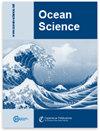Anthropogenic CO2, air–sea CO2 fluxes, and acidification in the Southern Ocean: results from a time-series analysis at station OISO-KERFIX (51° S–68° E)
IF 4.1
3区 地球科学
Q2 METEOROLOGY & ATMOSPHERIC SCIENCES
引用次数: 0
Abstract
Abstract. The temporal variation of the carbonate system, air–sea CO2 fluxes, and pH is analyzed in the southern Indian Ocean, south of the polar front, based on in situ data obtained from 1985 to 2021 at a fixed station (50°40′ S–68°25′ E) and results from a neural network model that reconstructs the fugacity of CO2 (fCO2) and fluxes at monthly scale. Anthropogenic CO2 (Cant) is estimated in the water column and is detected down to the bottom (1600 m) in 1985, resulting in an aragonite saturation horizon at 600 m that migrated up to 400 m in 2021 due to the accumulation of Cant. At the subsurface, the trend of Cant is estimated at +0.53±0.01 µmol kg−1 yr−1 with a detectable increase in the trend in recent years. At the surface during austral winter the oceanic fCO2 increased at a rate close to or slightly lower than in the atmosphere. To the contrary, in summer, we observed contrasting fCO2 and dissolved inorganic carbon (CT) trends depending on the decade and emphasizing the role of biological drivers on air–sea CO2 fluxes and pH inter-annual variability. The regional air–sea CO2 fluxes evolved from an annual source to the atmosphere of 0.8 molC m−2 yr−1 in 1985 to a sink of −0.5 molC m−2 yr−1 in 2020. Over 1985–2020, the annual pH trend in surface waters of -0.0165±0.0040 per decade was mainly controlled by the accumulation of anthropogenic CO2, but the summer pH trends were modulated by natural processes that reduced the acidification rate in the last decade. Using historical data from November 1962, we estimated the long-term trend for fCO2, CT, and pH, confirming that the progressive acidification was driven by the atmospheric CO2 increase. In 59 years this led to a diminution of 11 % for both aragonite and calcite saturation state. As atmospheric CO2 is expected to increase in the future, the pH and carbonate saturation state will decrease at a faster rate than observed in recent years. A projection of future CT concentrations for a high emission scenario (SSP5-8.5) indicates that the surface pH in 2100 would decrease to 7.32 in winter. This is up to −0.86 lower than pre-industrial pH and −0.71 lower than pH observed in 2020. The aragonite undersaturation in surface waters would be reached as soon as 2050 (scenario SSP5-8.5) and 20 years later for a stabilization scenario (SSP2-4.5) with potential impacts on phytoplankton species and higher trophic levels in the rich ecosystems of the Kerguelen Islands area.南大洋的人为二氧化碳、海气二氧化碳通量和酸化:OISO-KERFIX站(南纬51°-东经68°)的时间序列分析结果
摘要根据 1985 年至 2021 年在一个固定站(南纬 50°40′-东经 68°25′)获得的原位数据,以及重建二氧化碳逸度(fCO2)和月尺度通量的神经网络模型的结果,分析了极地前线以南南印度洋碳酸盐系统、海气二氧化碳通量和 pH 值的时间变化。对水体中的人为 CO2(Cant)进行了估算,1985 年探测到的 CO2 下至水底(1600 米),在 600 米处形成了文石饱和层,2021 年由于 CO2 的积累,文石饱和层上移至 400 米处。在次表层,Cant 的趋势估计为 +0.53±0.01 µmol kg-1 yr-1,近几年趋势有明显增加。在表层,澳大利亚冬季海洋 fCO2 的增加速率接近或略低于大气。相反,在夏季,我们观察到不同年代的 fCO2 和溶解无机碳(CT)趋势截然不同,并强调了生物驱动因素对海气二氧化碳通量和 pH 年际变化的作用。区域海气二氧化碳通量从 1985 年的年大气源 0.8 摩尔碳 m-2 yr-1 演变为 2020 年的年大气汇-0.5 摩尔碳 m-2 yr-1。1985-2020年间,地表水pH值的年变化趋势为每10年-0.0165±0.0040,主要受人为二氧化碳累积的控制,但夏季pH值的变化趋势受自然过程的调节,自然过程降低了过去10年的酸化速率。利用1962年11月的历史数据,我们估算了fCO2、CT和pH值的长期趋势,证实大气中二氧化碳的增加推动了逐步酸化。59年间,文石和方解石的饱和状态均下降了11%。由于预计未来大气中的二氧化碳会增加,pH 值和碳酸盐饱和状态的下降速度将比近年来观测到的更快。对高排放情景(SSP5-8.5)下未来二氧化碳浓度的预测表明,2100 年冬季地表 pH 值将降至 7.32。这比工业化前的 pH 值低 0.86,比 2020 年观测到的 pH 值低 0.71。地表水中的文石不饱和度最快将在 2050 年达到(SSP5-8.5 方案),稳定方案(SSP2-4.5 方案)将在 20 年后达到,可能会对凯尔盖朗群岛地区丰富生态系统中的浮游植物物种和较高营养级造成影响。
本文章由计算机程序翻译,如有差异,请以英文原文为准。
求助全文
约1分钟内获得全文
求助全文
来源期刊

Ocean Science
地学-海洋学
CiteScore
5.90
自引率
6.20%
发文量
78
审稿时长
6-12 weeks
期刊介绍:
Ocean Science (OS) is a not-for-profit international open-access scientific journal dedicated to the publication and discussion of research articles, short communications, and review papers on all aspects of ocean science: experimental, theoretical, and laboratory. The primary objective is to publish a very high-quality scientific journal with free Internet-based access for researchers and other interested people throughout the world.
Electronic submission of articles is used to keep publication costs to a minimum. The costs will be covered by a moderate per-page charge paid by the authors. The peer-review process also makes use of the Internet. It includes an 8-week online discussion period with the original submitted manuscript and all comments. If accepted, the final revised paper will be published online.
Ocean Science covers the following fields: ocean physics (i.e. ocean structure, circulation, tides, and internal waves); ocean chemistry; biological oceanography; air–sea interactions; ocean models – physical, chemical, biological, and biochemical; coastal and shelf edge processes; paleooceanography.
 求助内容:
求助内容: 应助结果提醒方式:
应助结果提醒方式:


